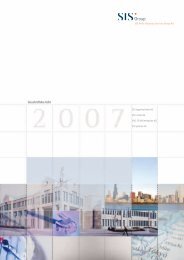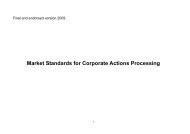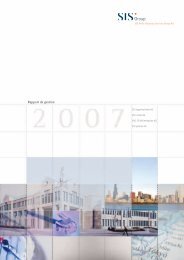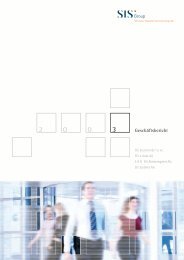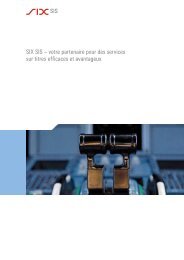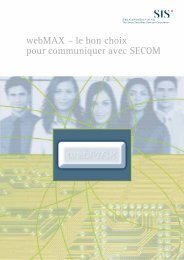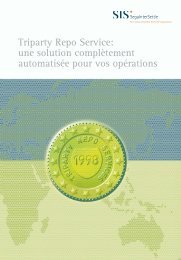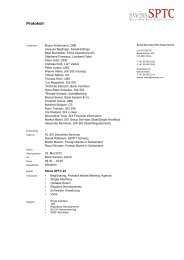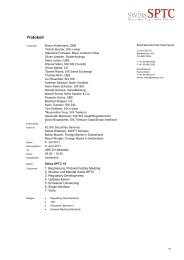Elimination of Giovannini Barrier One Final Protocol recommendation
Elimination of Giovannini Barrier One Final Protocol recommendation
Elimination of Giovannini Barrier One Final Protocol recommendation
You also want an ePaper? Increase the reach of your titles
YUMPU automatically turns print PDFs into web optimized ePapers that Google loves.
<strong>Elimination</strong> <strong>of</strong> <strong>Giovannini</strong><br />
<strong>Barrier</strong> <strong>One</strong><br />
<strong>Final</strong> <strong>Protocol</strong> <strong>recommendation</strong><br />
Andrew Douglas<br />
SWIFT<br />
March 2006
<strong>Giovannini</strong> <strong>Barrier</strong> <strong>One</strong> – <strong>Final</strong> <strong>Protocol</strong> <strong>recommendation</strong><br />
Table <strong>of</strong> contents<br />
Table <strong>of</strong> contents...............................................................................................................................1<br />
Foreword ............................................................................................................................................3<br />
1 Executive summary ...................................................................................................................4<br />
2 Introduction ................................................................................................................................6<br />
3 <strong>Protocol</strong> definition process ......................................................................................................6<br />
4 <strong>Protocol</strong> principles ....................................................................................................................7<br />
4.1 Market structure.................................................................................................................7<br />
4.2 Purpose <strong>of</strong> the <strong>Giovannini</strong> <strong>Protocol</strong> ...................................................................................7<br />
4.3 <strong>Protocol</strong> structure...............................................................................................................8<br />
4.4 <strong>Protocol</strong> scope ...................................................................................................................8<br />
4.4.1 Impact area...................................................................................................................8<br />
4.4.2 Instrument scope ..........................................................................................................9<br />
4.5 <strong>Protocol</strong> terminology..........................................................................................................9<br />
4.5.1 <strong>Protocol</strong>.........................................................................................................................9<br />
4.5.2 Data standard ...............................................................................................................9<br />
4.5.3 Data syntax.................................................................................................................11<br />
4.5.4 Participants, infrastructures and institutions...............................................................11<br />
4.6 Domestic versus cross-border applicability <strong>of</strong> the <strong>Protocol</strong>.............................................11<br />
4.7 Service provision .............................................................................................................11<br />
5 <strong>Protocol</strong> content ......................................................................................................................12<br />
5.1 Data layer for equities, fixed income and exchange traded funds ..................................12<br />
5.1.1 Element 1: Data standards.........................................................................................12<br />
5.1.2 Element 2: Data security ............................................................................................13<br />
5.1.3 Element 3: Data service .............................................................................................13<br />
5.2 Transfer layer for equities, fixed income and exchange traded funds.............................13<br />
5.2.1 Element 4: Transfer layer standards ..........................................................................13<br />
5.2.2 Element 5: Transfer layer security..............................................................................13<br />
5.2.3 Element 6: Transfer layer service...............................................................................14<br />
5.3 Exchange traded derivatives ...........................................................................................14<br />
6 <strong>Protocol</strong> implementation.........................................................................................................15<br />
7 <strong>Protocol</strong> support ......................................................................................................................17<br />
7.1 Central securities depositories ........................................................................................17<br />
7.2 Clearing houses and central counterparties....................................................................17<br />
7.3 Virtual matching utilities and electronic trade confirmation providers .............................17<br />
Gio_<strong>Barrier</strong>1_<strong>Protocol</strong>Recom_v2.doc Page 1
<strong>Giovannini</strong> <strong>Barrier</strong> <strong>One</strong> – <strong>Final</strong> <strong>Protocol</strong> <strong>recommendation</strong><br />
7.4 Institutions........................................................................................................................18<br />
7.5 Investment managers ......................................................................................................18<br />
7.6 Regulators .......................................................................................................................18<br />
7.7 Others ..............................................................................................................................19<br />
8 Monitoring.................................................................................................................................20<br />
9 Cost-benefit analysis...............................................................................................................21<br />
9.1 General industry ..............................................................................................................21<br />
9.2 Participant type ................................................................................................................21<br />
10 Next steps.................................................................................................................................23<br />
Attachment 1: Composition <strong>of</strong> Independent Advisory Group ....................................................24<br />
Attachment 2: ISO 15022 and ISO 20022 compared ....................................................................25<br />
Attachment 3: Glossary ..................................................................................................................27<br />
Gio_<strong>Barrier</strong>1_<strong>Protocol</strong>Recom_v2.doc Page 2
<strong>Giovannini</strong> <strong>Barrier</strong> <strong>One</strong> – <strong>Final</strong> <strong>Protocol</strong> <strong>recommendation</strong><br />
Foreword<br />
“SWIFT has contributed to the elimination <strong>of</strong> the so-called <strong>Barrier</strong> <strong>One</strong> with great determination. It has<br />
provided a model for other private-sector initiatives aimed at making European clearing and settlement a<br />
fully integrated function. SWIFT has moved fast to secure a mandate (informal, <strong>of</strong> course) from CESAME<br />
and has immediately embarked on a complex and structured process <strong>of</strong> analysis and consultation.<br />
Since the beginning, SWIFT has periodically informed its user community and the wider marketplace<br />
through CESAME. The process has been highly efficient and successful in developing new standards<br />
which de facto eliminate <strong>Barrier</strong> <strong>One</strong>. The next fundamental phase is the adoption <strong>of</strong> these standards<br />
which is the result <strong>of</strong> voluntary decisions by market participants. The European Central Bank’s decision to<br />
support the new standards will be an important factor in securing their quick adoption.”<br />
Alberto <strong>Giovannini</strong><br />
Chairman, <strong>Giovannini</strong> Group<br />
March 2006<br />
"The ESCB supports and appreciates the work done so far in helping to remove technical obstacles to<br />
market integration and paving the way towards standardized, harmonized and efficient clearing and<br />
settlement systems in Europe.<br />
In line with the timeline identified, and assuming the protocol is implemented by other major market<br />
players, the ESCB will also adopt it for its operations.”<br />
Daniela Russo<br />
Deputy Director General<br />
Directorate General Payment Systems and Market Infrastructure<br />
March 2006<br />
“The recommended protocol represents an indispensable contribution to integrate the European capital<br />
markets and to make cross-border Clearing & Settlement more efficient, less costly and less risky.<br />
The removal <strong>of</strong> <strong>Barrier</strong> <strong>One</strong> is essential and a pre-requisite for the dismantling <strong>of</strong> other barriers identified<br />
by the <strong>Giovannini</strong> Group. The work done by the Independent Advisory Group is congruent and<br />
complementary to the work on the broader Recommendation 2 <strong>of</strong> the Group <strong>of</strong> Thirty. It is also worth<br />
mentioning that through the efforts in designing this solution by the industry for the industry, the private<br />
sector underlines its willingness to contribute to the reduction <strong>of</strong> impediments in cross-border Clearing &<br />
Settlement in Europe.”<br />
Stephan Schuster<br />
Chairman <strong>of</strong> Independent Advisory Group<br />
Co Chair <strong>of</strong> the European G30 Monitoring Group<br />
March 2006<br />
Gio_<strong>Barrier</strong>1_<strong>Protocol</strong>Recom_v2.doc Page 3
<strong>Giovannini</strong> <strong>Barrier</strong> <strong>One</strong> – <strong>Final</strong> <strong>Protocol</strong> <strong>recommendation</strong><br />
1 Executive summary<br />
The <strong>Giovannini</strong> <strong>Protocol</strong> has been defined on behalf <strong>of</strong> the clearing and settlement industry by a<br />
representative group <strong>of</strong> key industry participants, the Independent Advisory Group (IAG - see Attachment<br />
1). The <strong>Protocol</strong> has also been subject to multiple industry reviews and has been endorsed by a<br />
substantial number <strong>of</strong> key European Union (EU) clearing and settlement industry participants.<br />
The key <strong>Protocol</strong> <strong>recommendation</strong>s are summarised in the following six elements:<br />
For equities,<br />
fixed income<br />
and exchange<br />
traded funds<br />
Element 1:<br />
Data standards<br />
Element 2:<br />
Data security<br />
Element 3:<br />
Data service<br />
a) It is mandatory for all participants in EU cross-border<br />
clearing and settlement and asset servicing <strong>of</strong> equities, fixed<br />
income and exchange traded funds, to implement support for<br />
the use <strong>of</strong> ISO 15022 and ISO 20022 standards and syntaxes,<br />
with coexistence solutions where appropriate, in compliance<br />
with existing market practices <strong>of</strong> the Securities Market Practice<br />
Group (SMPG).<br />
b) It is mandatory for all EU infrastructures to implement<br />
support for ISO 15022 and ISO 20022 standards and syntaxes<br />
in compliance with existing SMPG market practices to enable<br />
institutions engaged in domestic clearing and settlement<br />
activity to use these standards and syntaxes where<br />
appropriate. The long-term aim is to provide all domestic and<br />
cross-border clearing and settlement institutions with the<br />
common option to use ISO 15022 and ISO 20022 standards<br />
and syntaxes.<br />
c) It is mandatory that all participants in EU clearing and<br />
settlement implement support for all ISO data standards<br />
relevant to ISO 15022 and ISO 20022 as they are approved.<br />
This does not prevent the necessary use <strong>of</strong> local non-ISO<br />
standards where domestic users require this support.<br />
Where relevant to other EU initiatives, such as the Markets in<br />
Financial Instruments Directive (MiFID), support for these<br />
standards should be implemented to ensure straight-through<br />
processing from pre-trade to asset servicing.<br />
This is out <strong>of</strong> scope, as data security, that is security <strong>of</strong> data<br />
before sending and after receiving, is typically the<br />
responsibility <strong>of</strong> either the target application or the participant<br />
using the data. Security during transfer <strong>of</strong> data is dealt with in<br />
Element 5.<br />
A gap analysis <strong>of</strong> the ISO 15022 and ISO 20022 message<br />
suite must be completed by SWIFT’s Standards Department<br />
for all infrastructures in all EU States (plus other countries as<br />
necessary) to identify missing functionality. Standards must<br />
then be extended to include this functionality.<br />
Gio_<strong>Barrier</strong>1_<strong>Protocol</strong>Recom_v2.doc Page 4
<strong>Giovannini</strong> <strong>Barrier</strong> <strong>One</strong> – <strong>Final</strong> <strong>Protocol</strong> <strong>recommendation</strong><br />
For exchange<br />
traded<br />
derivatives<br />
<strong>Protocol</strong><br />
implementation<br />
Cost-benefit<br />
analysis<br />
Element 4:<br />
Transfer layer<br />
standards<br />
Element 5:<br />
Transfer layer<br />
security<br />
It is mandatory for a <strong>Giovannini</strong>-compliant transfer layer to<br />
<strong>of</strong>fer machine to machine data transfer services with the<br />
following features:<br />
Use <strong>of</strong> ISO 15022 and ISO 20022 structured messages and<br />
file formats where they exist<br />
Internet <strong>Protocol</strong> (IP) for communication and routing<br />
It is recommended that a <strong>Giovannini</strong>-compliant transfer layer<br />
also <strong>of</strong>fer manual operator based data transfer services via a<br />
graphical user interface (GUI) using ISO 15022 and ISO<br />
20022 structured messages and file formats, where they exist.<br />
A <strong>Giovannini</strong>-compliant transfer layer must:<br />
Apply the following security services to all machine to machine<br />
transfers (and GUI, if provided):<br />
• Authentication and data integrity, via PKI<br />
• Non-repudiation<br />
• Time stamping<br />
The Certificate Registration Authority associated with the PKI<br />
service must implement industry recognised best practices for<br />
certificate issuance.<br />
Market best practice minimum key strength must be<br />
implemented.<br />
Element 6: A <strong>Giovannini</strong>-compliant transfer layer must:<br />
Transfer layer<br />
service<br />
•<br />
•<br />
Be at least available during TARGET opening hours<br />
Satisfy business and regulatory requirements for<br />
performance, resilience and network management<br />
• Provide the following services:<br />
– Audit log <strong>of</strong> message or file (retention in accordance<br />
with local requirements as specified by the relevant<br />
securities regulator)<br />
– Guaranteed delivery <strong>of</strong> message or file<br />
– Delivery once, and only once, <strong>of</strong> message or file<br />
Relevant expert bodies such as the Futures Industry Association (FIA), Futures<br />
and Options Association (FOA), FpML, Eurex, LCH.Clearnet and FIX <strong>Protocol</strong> Ltd<br />
must consult on the feasibility and, if appropriate, recommend a plan to achieve<br />
compliance with the <strong>Protocol</strong> for exchange traded derivatives.<br />
It is mandatory for all participants to complete implementation during a five year<br />
window beginning March 2006. Implementation will be staged over that period<br />
according to the individual plans <strong>of</strong> each participant. Compliance will therefore<br />
ramp up over the implementation period.<br />
Implementation monitoring will be done in conjunction with ISSA and related to<br />
corresponding monitoring <strong>of</strong> G30 Recommendation 2. A key deliverable for the<br />
end <strong>of</strong> 2006 will be a mapping <strong>of</strong> all EU infrastructure plans for compliance during<br />
the implementation window.<br />
Qualitatively, the benefits are clear, improved efficiency and reduced risk. A<br />
quantitative cost-benefit analysis will be delivered by the end <strong>of</strong> 2006.<br />
Gio_<strong>Barrier</strong>1_<strong>Protocol</strong>Recom_v2.doc Page 5
<strong>Giovannini</strong> <strong>Barrier</strong> <strong>One</strong> – <strong>Final</strong> <strong>Protocol</strong> <strong>recommendation</strong><br />
2 Introduction<br />
In 2001, the <strong>Giovannini</strong> group, as advisor to the European Commission, published a report identifying 15<br />
‘barriers’ to efficient and cost-effective cross-border clearing and settlement <strong>of</strong> securities transactions<br />
within the European Union (EU). These barriers have become apparent as 25 separate countries, each<br />
with its own domestically focused legal regime, fiscal policy and national infrastructure supporting the local<br />
securities market, work towards the creation <strong>of</strong> a single integrated European capital market.<br />
In April 2003, a second report identified the organisations responsible for defining solutions to the<br />
elimination <strong>of</strong> each barrier. The <strong>Barrier</strong> <strong>One</strong> <strong>recommendation</strong> was:<br />
“National differences in the information technology and interfaces used by clearing and settlement<br />
providers should be eliminated via an EU-wide protocol. SWIFT should ensure the definition <strong>of</strong> this<br />
protocol through the Securities Market Practice Group (SMPG). Once defined, the <strong>Protocol</strong> should be<br />
immediately adopted by the European System <strong>of</strong> Central Banks (ESCB) in respect <strong>of</strong> its operations. This<br />
barrier should be removed within two years from the initiation <strong>of</strong> this project.”<br />
SWIFT accepted this responsibility and agreed with the SMPG chairman that it would carry out the<br />
necessary research to define the required <strong>Protocol</strong> with direct SMPG input.<br />
3 <strong>Protocol</strong> definition process<br />
A consultation paper published in early 2005 contained a suggested protocol structure. Consultation<br />
feedback can be viewed at www.swift.com/index.cfm?item_id=43429.<br />
A key element <strong>of</strong> the feedback was that SWIFT should continue to define the <strong>Protocol</strong> guided by the four<br />
principles <strong>of</strong> leverage, inclusivity, openness and neutrality.<br />
An Independent Advisory Group (IAG - see Attachment 1) was formed based on membership <strong>of</strong> the EU’s<br />
Clearing and Settlement Advisory and Monitoring Experts (CESAME) Group to maintain these principles,<br />
analyse feedback and define the <strong>Protocol</strong>. IAG membership plus all meeting minutes and slides can be<br />
viewed at www.swift.com/index.cfm?item_id=43429.<br />
A draft <strong>Protocol</strong> was published for industry review between 25 October 2005 and 27 January 2006. All<br />
feedback received can be viewed at www.swift.com/index.cfm?item_id=43429.<br />
This document defines the <strong>Protocol</strong> proposed to eliminate <strong>Giovannini</strong> <strong>Barrier</strong> <strong>One</strong>.<br />
Gio_<strong>Barrier</strong>1_<strong>Protocol</strong>Recom_v2.doc Page 6
<strong>Giovannini</strong> <strong>Barrier</strong> <strong>One</strong> – <strong>Final</strong> <strong>Protocol</strong> <strong>recommendation</strong><br />
4 <strong>Protocol</strong> principles<br />
4.1 Market structure<br />
The interaction <strong>of</strong> market participants across the transaction lifecycle can be generically represented as<br />
shown below in Diagram 1 and is used as the agreed basic market shape.<br />
Space 1<br />
Pre-trade/<br />
Trade<br />
Space 2<br />
Post Trade/<br />
Pre-Settlement<br />
Space 3<br />
Clearing &<br />
Settlement<br />
Trade date<br />
Trade date + X<br />
Institutional (buy) side Street (sell) side<br />
Order<br />
IMI B/D Trade B/D<br />
VMU /<br />
ETCP<br />
Exchange<br />
GC CCP<br />
SC<br />
SA<br />
Central Depositories<br />
Non trade-related activity<br />
Space 4<br />
Asset Servicing<br />
SA<br />
Diagram 1: Basic market shape<br />
4.2 Purpose <strong>of</strong> the <strong>Giovannini</strong> <strong>Protocol</strong><br />
1<br />
2<br />
3<br />
IMI: Investment<br />
Manager<br />
B/D: Broker Dealer<br />
VMU: Virtual Matching<br />
Utility<br />
ETCP: Electronic Trade<br />
Confirm Provider<br />
GC: Global Customer<br />
SC: Sub-Customer<br />
SA: Settlement Agent<br />
(Clearer)<br />
CCP: Clearing House/<br />
Central<br />
counterparty<br />
Cash Clearing<br />
systems/<br />
Central Banks<br />
Without a single authoritative body defining a solution, there has been no agreed baseline toward which<br />
infrastructures could develop local solutions, leading to the creation <strong>of</strong> the current patchwork <strong>of</strong> solutions<br />
using local standards and technology.<br />
The <strong>Giovannini</strong> <strong>Protocol</strong> defines an agreed set <strong>of</strong> EU-wide data standards and technology<br />
<strong>recommendation</strong>s aimed at creating an environment where all industry participants can interoperate,<br />
eliminating some <strong>of</strong> the complexity and cost <strong>of</strong> cross-border clearing and settlement.<br />
There is no <strong>recommendation</strong> <strong>of</strong> a <strong>Protocol</strong> review period, based on the assumption that its implementation<br />
will eliminate <strong>Barrier</strong> <strong>One</strong> and provide standardisation that should not be displaced by technological<br />
advancement.<br />
Gio_<strong>Barrier</strong>1_<strong>Protocol</strong>Recom_v2.doc Page 7
<strong>Giovannini</strong> <strong>Barrier</strong> <strong>One</strong> – <strong>Final</strong> <strong>Protocol</strong> <strong>recommendation</strong><br />
4.3 <strong>Protocol</strong> structure<br />
The <strong>Protocol</strong> is based on a two-layer structure and comprises a definition <strong>of</strong> the minimum mandatory<br />
content <strong>of</strong> each <strong>of</strong> the six elements identified below in Diagram 2.<br />
Data<br />
Transfer<br />
4.4 <strong>Protocol</strong> scope<br />
4.4.1 Impact area<br />
Standards Security Service<br />
Element<br />
1<br />
Element<br />
4<br />
Element<br />
2<br />
Element<br />
5<br />
Element<br />
3<br />
Element<br />
6<br />
Diagram 2: Six element protocol structure<br />
Data<br />
Transfer<br />
For ‘buy-side’ communication, the <strong>Protocol</strong> should be used to generate all input to the global custodian,<br />
local custodian and (I)CSD. This will therefore include the outputs <strong>of</strong> any virtual matching utility (VMU) or<br />
electronic trade confirmation (ETC) provider, the global and local custodian and the (I)CSD. It should also<br />
include the output <strong>of</strong> the investment manager (IMI) and this is to be encouraged, although it should be<br />
recognised that IMI activity is out <strong>of</strong> scope <strong>of</strong> the <strong>Protocol</strong>.<br />
For ‘sell-side’ communication, the <strong>Protocol</strong> should be used to generate all inputs to the settlement agent<br />
and (I)CSD. This will therefore include the outputs <strong>of</strong> the clearing house or central counterparty (CCP),<br />
settlement agent and the (I)CSD.<br />
The impact area is represented graphically in Diagram 3.<br />
Gio_<strong>Barrier</strong>1_<strong>Protocol</strong>Recom_v2.doc Page 8
<strong>Giovannini</strong> <strong>Barrier</strong> <strong>One</strong> – <strong>Final</strong> <strong>Protocol</strong> <strong>recommendation</strong><br />
Space 1<br />
Pre-trade/<br />
Trade<br />
Space 2<br />
Post Trade/<br />
Pre-Settlement<br />
Space 3<br />
Clearing &<br />
Settlement<br />
Trade date<br />
Trade date + X<br />
Institutional (buy) side<br />
IMI<br />
Order<br />
VMU /<br />
ETCP<br />
Area <strong>of</strong><br />
GC<br />
SC mandatory<br />
<strong>Protocol</strong><br />
usage<br />
4.4.2 Instrument scope<br />
B/D<br />
SA<br />
Central Depositories<br />
Street (sell) side<br />
Trade<br />
Exchange<br />
CCP<br />
Non trade-related activity<br />
Space 4<br />
Asset Servicing<br />
B/D<br />
SA<br />
Diagram 3: <strong>Protocol</strong> impact area<br />
1<br />
2<br />
3<br />
Cash Clearing<br />
systems/<br />
Central Banks<br />
From the original <strong>Giovannini</strong> report, the instruments in scope are clearly equities, fixed income and<br />
exchange traded derivatives. As clearing and settlement <strong>of</strong> exchange traded funds occurs in the same<br />
way as equities, they are also considered to be in scope. Non-exchange traded funds, over the counter<br />
(OTC) derivatives and commodities have not been explicitly considered in this paper, although<br />
implementation <strong>of</strong> the <strong>Protocol</strong> in these sectors is actively encouraged.<br />
4.5 <strong>Protocol</strong> terminology<br />
4.5.1 <strong>Protocol</strong><br />
For the purposes <strong>of</strong> this document, the <strong>Protocol</strong> has been defined as a set <strong>of</strong> best practice rules governing<br />
communication procedures between any two counterparties. This includes a data standard and syntax<br />
and a number <strong>of</strong> technology elements associated with the transfer <strong>of</strong> data.<br />
4.5.2 Data standard<br />
Within this <strong>Protocol</strong>, a data standard is defined as having four components:<br />
• A single agreed business process model<br />
• A single data dictionary <strong>of</strong> agreed business data elements and their definitions<br />
• A catalogue <strong>of</strong> messages developed using agreed data elements and syntax<br />
• A set <strong>of</strong> agreed market practices, where relevant.<br />
The <strong>Protocol</strong> recommends (see Section 5) the concurrent use <strong>of</strong> ISO 15022 and ISO 20022 as standards<br />
for the EU clearing and settlement industry.<br />
The four elements identified above are stored in the ISO 20022 Repository, where they are available for<br />
inspection and use by all participants in the global financial services industry, confirming the drive <strong>of</strong> the<br />
Gio_<strong>Barrier</strong>1_<strong>Protocol</strong>Recom_v2.doc Page 9
<strong>Giovannini</strong> <strong>Barrier</strong> <strong>One</strong> – <strong>Final</strong> <strong>Protocol</strong> <strong>recommendation</strong><br />
International Organisation for Standardisation (ISO) towards the development <strong>of</strong> open standards. A<br />
summary <strong>of</strong> the characteristics <strong>of</strong> ISO 15022 and ISO 20022 is contained in Attachment 2.<br />
Clearly, today there is little relationship between ISO and non-ISO standards, and this is a core issue that<br />
the European securities industry, and indeed the global financial services industry, faces in relation to the<br />
development <strong>of</strong> true, cost effective straight-through processing. As discussed in earlier papers, multiple<br />
standards exist within market spaces and within instrument silos, although it is clear that ISO 20022 is<br />
gaining acceptance across all areas <strong>of</strong> the European market, as illustrated in Diagram 4.<br />
Space 1<br />
Pre-trade/<br />
Trade<br />
Space 2<br />
Post Trade/<br />
Pre-Settlement<br />
Space 3<br />
Clearing &<br />
Settlement<br />
Trade date<br />
Trade date + X<br />
Institutional (buy) side Street (sell) side<br />
Order<br />
IMI B/D Trade B/D<br />
VMU /<br />
ETCP<br />
Exchange<br />
GC CCP<br />
SC<br />
MiFID<br />
ISO 20022<br />
Option<br />
<strong>Giovannini</strong><br />
SA<br />
ISO 20022<br />
Central (inc ISO Depositories 15022)<br />
Mandatory<br />
Non trade-related activity<br />
Space 4<br />
Asset Servicing<br />
SA<br />
1<br />
2 SEPA<br />
ISO 20022<br />
Cash Clearing Target 2<br />
systems/<br />
Central Banks<br />
3ISO<br />
20022<br />
Mandatory<br />
Diagram 4: ISO 20022 as a common standard for the EU financial service industry<br />
It is hoped that the flexibility, open nature and inclusiveness <strong>of</strong> ISO 20022 will encourage existing<br />
standards in other domains to subscribe to the ISO 20022 Repository, which would lead to the creation in<br />
future <strong>of</strong> a fully interoperable <strong>Protocol</strong> hierarchy as shown in Diagram 5.<br />
Syntax<br />
Standard<br />
<strong>Protocol</strong><br />
ISO 20022<br />
XML<br />
ISO15022<br />
FIX 4.X<br />
<strong>Giovannini</strong><br />
<strong>Protocol</strong><br />
ISO 20022<br />
Data Dictionary/<br />
Process model/<br />
Market practice/<br />
Message catalogue<br />
FPML<br />
TWIST<br />
Diagram 5: A fully interoperable <strong>Protocol</strong> hierarchy<br />
MDDL<br />
Gio_<strong>Barrier</strong>1_<strong>Protocol</strong>Recom_v2.doc Page 10<br />
Slide 4
<strong>Giovannini</strong> <strong>Barrier</strong> <strong>One</strong> – <strong>Final</strong> <strong>Protocol</strong> <strong>recommendation</strong><br />
4.5.3 Data syntax<br />
A syntax is the manner in which data elements are assembled to form a message. Some syntaxes are<br />
also considered to be standards, such as ISO 15022 and FIX, as they include a data dictionary and a<br />
process model. In general, translation between syntaxes is facilitated through the adoption <strong>of</strong> a single data<br />
dictionary and a single process model, as identified above.<br />
4.5.4 Participants, infrastructures and institutions<br />
In this document, the terms ‘participant’, ‘infrastructure’ and ‘institution’ are used extensively.<br />
‘Participants’ – A collective term for all players in the clearing and settlement industry. This includes<br />
infrastructures and institutions.<br />
‘Infrastructures’ – All commonly recognised cash and securities clearing and settlement systems and<br />
their operators, such as central securities depositories, clearing houses and central counterparties and<br />
central banks. For the purposes <strong>of</strong> this <strong>Protocol</strong>, virtual matching utilities (VMU) and electronic trade<br />
confirmation (ETC) providers are also included in this category.<br />
‘Institutions’ – Refers to broker-dealers, custodians, settlement agents and ancillary institutions such as<br />
transfer agents that access services provided by infrastructures in the commission <strong>of</strong> clearing and<br />
settlement business.<br />
4.6 Domestic versus cross-border applicability <strong>of</strong> the <strong>Protocol</strong><br />
During the 2001 Lisbon Summit, the leaders <strong>of</strong> the European States clearly outlined their belief in the<br />
benefits associated with the creation <strong>of</strong> a single integrated financial market for Europe. Ultimately, this is<br />
the goal on which many EU initiatives are converging, such as the Markets in Financial Instruments<br />
Directive (MiFID) and <strong>Giovannini</strong> for the securities market, together with the Single Euro Payment Area<br />
(SEPA) and Target 2 for corresponding payments markets. After implementation <strong>of</strong> these solutions, there<br />
will be no distinction between cross-border and domestic transactions in the EU, there will only be EU<br />
domestic activity.<br />
Within this EU domestic framework, all infrastructures will be accessible by all institutions. Thus,<br />
institutions operating ‘near’ to an infrastructure (today’s domestic user) will find themselves<br />
communicating via a different <strong>Protocol</strong> to those institutions ‘far’ from the same infrastructure (today’s<br />
cross-border user). Conversely, when ‘near’ institutions attempt to exploit new business opportunities that<br />
arise in the single integrated financial market by accessing a ‘far’ infrastructure, the only viable option will<br />
be via a <strong>Giovannini</strong>-compliant protocol. Over time, institutions will therefore have to implement the<br />
<strong>Protocol</strong> to communicate with ‘far’ infrastructures. This will stimulate demand to their ‘near’ infrastructures<br />
and provide the impetus for total market standardisation on this <strong>Protocol</strong>.<br />
Opinion submitted during the review <strong>of</strong> the draft <strong>Protocol</strong> clearly demonstrates a belief that maximum<br />
economy <strong>of</strong> scale, and thus maximum benefit, will be derived through implementation <strong>of</strong> the <strong>Protocol</strong> for<br />
‘near’ (domestic) as well as ‘far’ (cross-border) clearing and settlement activity. This document does not<br />
specify a time by when this must happen as this is beyond the scope <strong>of</strong> the <strong>Protocol</strong> but it does encourage<br />
such take up as early as possible.<br />
4.7 Service provision<br />
Transfer layer functionality is independent <strong>of</strong> data layer, and can be sourced from single or multiple<br />
providers according to the preference <strong>of</strong> the purchaser (see Section 5.2.1).<br />
Gio_<strong>Barrier</strong>1_<strong>Protocol</strong>Recom_v2.doc Page 11
<strong>Giovannini</strong> <strong>Barrier</strong> <strong>One</strong> – <strong>Final</strong> <strong>Protocol</strong> <strong>recommendation</strong><br />
5 <strong>Protocol</strong> content<br />
5.1 Data layer for equities, fixed income and exchange traded<br />
funds<br />
5.1.1 Element 1: Data standards<br />
a) It is mandatory for all participants in EU cross-border clearing and settlement and asset servicing <strong>of</strong><br />
equities, fixed income and exchange traded funds to implement support for the use <strong>of</strong> ISO 15022 and ISO<br />
20022 standards and syntaxes, with coexistence solutions where appropriate, in compliance with existing<br />
SMPG market practices. ‘All participants’ includes, but is not limited to:<br />
• Virtual matching utilities and electronic trade confirmation providers*<br />
• Clearing houses and central counterparties*<br />
• [I]CSDs<br />
• Central banks and cash clearing systems<br />
• Broker-dealers<br />
• Subcustodians and global custodians<br />
• Local and global settlement agents<br />
• Entities supporting asset servicing activity, such as transfer agents<br />
For entities marked *, which operate at a perceived boundary between two syntaxes, the generation <strong>of</strong><br />
ISO 15022 and ISO 20022 messages into the downstream process is mandatory. The additional system<br />
support to accept inbound ISO 15022 and ISO 20022 messages is a recommended option. For all other<br />
entities, acceptance and generation <strong>of</strong> ISO 15022 and ISO 20022 messages, where they exist, is<br />
mandatory.<br />
b) It is mandatory for all EU infrastructures to implement support for ISO 15022 and ISO 20022 standards<br />
and syntaxes in compliance with existing SMPG market practices to enable institutions engaged in<br />
domestic clearing and settlement activity to use these standards and syntaxes where appropriate. The<br />
long term aim is to provide all domestic and cross-border clearing and settlement institutions with the<br />
common option to use ISO 15022 and ISO 20022 standards and syntaxes.<br />
c) It is mandatory that all participants in EU clearing and settlement implement support for all ISO data<br />
standards relevant to ISO 15022 and ISO 20022, as they are approved. This includes, but is not limited to:<br />
ISO 3166 – Country Codes ISO 4217 – Currency codes<br />
ISO 6166 – ISIN ISO 8601 – Date and time format<br />
ISO 9362 – BIC ISO 10383 – MIC<br />
ISO 10962 – CFI ISO 13616 – IBAN<br />
This does not prevent the necessary use <strong>of</strong> local non-ISO standards where domestic users require this<br />
support.<br />
Where relevant to other EU initiatives, such as MiFID, support for these standards should be implemented<br />
to ensure STP from pre-trade to asset servicing. Non-compliant syntaxes should become compliant with<br />
the ISO 15022 and ISO 20022 standard as defined in Section 4.5.2.<br />
Gio_<strong>Barrier</strong>1_<strong>Protocol</strong>Recom_v2.doc Page 12
<strong>Giovannini</strong> <strong>Barrier</strong> <strong>One</strong> – <strong>Final</strong> <strong>Protocol</strong> <strong>recommendation</strong><br />
5.1.2 Element 2: Data security<br />
This is out <strong>of</strong> scope as security <strong>of</strong> data before sending and after receiving is typically the responsibility <strong>of</strong><br />
either the target application or the participant using the data. Security during transfer <strong>of</strong> data is dealt with<br />
in Element 5 (see Section 5.2.2).<br />
5.1.3 Element 3: Data service<br />
a) A gap analysis <strong>of</strong> the ISO 15022 and ISO 20022 message suite must be completed by SWIFT<br />
Standards Department for all infrastructures in all EU States (plus other countries as necessary) to identify<br />
missing functionality. Standards must then be extended to include this functionality.<br />
The gap analysis should prioritise the analysis <strong>of</strong> discrete processes, such as settlement instruction, for all<br />
countries, rather than look at all processes for a specific country.<br />
b) If required, mapping between syntaxes (for example at the interface between trade and post-trade<br />
activity) will be conducted by the relevant standards authorities on a country by country basis and at a<br />
product by product level, in compliance with existing market practice and business rules.<br />
c) To ensure timely maintenance <strong>of</strong> ISO 15022 and ISO 20022 messages and to allow for continued<br />
innovation <strong>of</strong> processes and instruments, custom messages can be created using extensibility tools and<br />
rules provided by the standards authority, pending incorporation into the ISO 15022 and ISO 20022<br />
standards.<br />
5.2 Transfer layer for equities, fixed income and exchange traded<br />
funds<br />
5.2.1 Element 4: Transfer layer standards<br />
It is mandatory for a <strong>Giovannini</strong>-compliant transfer layer to <strong>of</strong>fer machine to machine data transfer<br />
services with the following features:<br />
• Use <strong>of</strong> ISO 15022 and ISO 20022 structured messages and file formats where they exist<br />
• Internet <strong>Protocol</strong> (IP) for communication and routing<br />
It is recommended that a <strong>Giovannini</strong>-compliant transfer layer also <strong>of</strong>fer manual operator based data<br />
transfer services via a graphical user interface (GUI) using ISO 15022 and ISO 20022 structured<br />
messages and file formats where they exist<br />
Note: Transfer layer providers do not need to <strong>of</strong>fer every service as part <strong>of</strong> their commercial <strong>of</strong>fering, but<br />
each participant must be able to transfer data using the mandatory service identified above. Selection <strong>of</strong><br />
transfer services appropriate to a specific communication is agreed bilaterally between participants.<br />
5.2.2 Element 5: Transfer layer security<br />
A <strong>Giovannini</strong>-compliant transfer layer must:<br />
• Apply the following security services to all machine to machine transfers (and GUI, if provided):<br />
– Authentication and data integrity, via public key infrastructure (PKI)<br />
– Non-repudiation<br />
– Time stamping<br />
Liability arising from authentication and non-repudiation can vary from 0-100% according to the<br />
commercial positioning <strong>of</strong> the service by the transfer layer provider.<br />
• The Certificate Registration Authority associated with the PKI service must implement industry<br />
recognised best practices for certificate issuance.<br />
• Market best practice minimum key strength must be implemented.<br />
Gio_<strong>Barrier</strong>1_<strong>Protocol</strong>Recom_v2.doc Page 13
<strong>Giovannini</strong> <strong>Barrier</strong> <strong>One</strong> – <strong>Final</strong> <strong>Protocol</strong> <strong>recommendation</strong><br />
5.2.3 Element 6: Transfer layer service<br />
A <strong>Giovannini</strong>-compliant transfer layer must:<br />
• be at least available during TARGET opening hours<br />
• satisfy business and regulatory requirements for performance, resilience and network management<br />
• provide the following services:<br />
– Audit log <strong>of</strong> message or file (retention in accordance with local requirements as specified by the<br />
relevant securities regulator)<br />
– Guaranteed delivery <strong>of</strong> message or file<br />
– Delivery once and only once <strong>of</strong> message or file<br />
5.3 Exchange traded derivatives<br />
Relevant expert bodies such as the Futures Industry Association (FIA), Futures and Options Association<br />
(FOA), FpML, Eurex, LCH.Clearnet and FIX <strong>Protocol</strong> Ltd must consult on the feasibility and, if appropriate,<br />
recommend a plan to achieve compliance with the <strong>Protocol</strong> for exchange traded derivatives.<br />
During pre-publication feedback, FIA accepted responsibility to lead an industry consultation on the<br />
applicability <strong>of</strong> the <strong>Protocol</strong> to global exchange traded derivatives. This study will be delivered within two<br />
years <strong>of</strong> publication <strong>of</strong> the <strong>Protocol</strong>, with a plan to achieve compliance within five years <strong>of</strong> publication <strong>of</strong><br />
the <strong>Protocol</strong>, if relevant.<br />
Gio_<strong>Barrier</strong>1_<strong>Protocol</strong>Recom_v2.doc Page 14
<strong>Giovannini</strong> <strong>Barrier</strong> <strong>One</strong> – <strong>Final</strong> <strong>Protocol</strong> <strong>recommendation</strong><br />
6 <strong>Protocol</strong> implementation<br />
Following extensive consultation with the clearing and settlement participants, implementation <strong>of</strong> the<br />
<strong>Protocol</strong> over a five year continuum, commencing from publication in March 2006, has been identified as<br />
an achievable solution. This continuum is illustrated in Diagram 6. This establishes a minimum <strong>Protocol</strong><br />
‘shelf life’ <strong>of</strong> five years, and whilst it may preclude the use <strong>of</strong> the latest developments, it provides<br />
participants with the certainty <strong>of</strong> a realistic period for amortisation <strong>of</strong> development costs. It encourages<br />
early implementation to give the longest period <strong>of</strong> guaranteed usage. This guarantee period is felt to be<br />
one <strong>of</strong> the best ways to promote take up, ensuring participants have time to recoup their investment in the<br />
<strong>Protocol</strong>.<br />
ISO 15022 and ISO 20022 gap closure<br />
ISO 15022 and ISO 20022 gap analysis<br />
Compliance by domestic participants<br />
(from when local MI <strong>of</strong>fers local ISO 15022 and ISO 20022 compliance<br />
Exchange traded derivatives compliance<br />
Exchange traded derivatives plan<br />
Compliance by all cross-border participants<br />
Staged compliance by all market infrastructures<br />
Implementation by participant type:<br />
Year 1 Year 2 Year 3 Year 4 Year 5<br />
Diagram 6: The implementation continuum<br />
Infrastructures It is mandatory for all infrastructures supporting the clearing and settlement <strong>of</strong><br />
equity, fixed income and exchange traded funds, that is VMU and ETC providers,<br />
clearing houses and CCPs* and (I)CSDs to have implemented support for the data<br />
and transfer layers by March 2011.<br />
The majority <strong>of</strong> infrastructures have indicated their willingness to adopt the <strong>Protocol</strong><br />
(see Section 7.1) predominantly by a staged implementation. Consequently, for<br />
certain infrastructures, implementation projects are already underway and will<br />
ensure compliance in certain areas will be achieved well before 2011. As part <strong>of</strong> the<br />
implementation monitoring process (see Section 8), a roadmap <strong>of</strong> implementation<br />
plans for all infrastructures will be drafted by the end <strong>of</strong> 2006.<br />
* See Section 7.2 for further information related to clearing houses and CCPs.<br />
Gio_<strong>Barrier</strong>1_<strong>Protocol</strong>Recom_v2.doc Page 15
<strong>Giovannini</strong> <strong>Barrier</strong> <strong>One</strong> – <strong>Final</strong> <strong>Protocol</strong> <strong>recommendation</strong><br />
Cross-border<br />
institutions<br />
Domestic<br />
institutions<br />
Others<br />
It is mandatory for all institutions engaged in cross-border clearing and settlement<br />
<strong>of</strong> equity, fixed income and exchange traded funds, that is broker-dealers, global<br />
and sub-custodians, global and local settlement agents, to implement support for<br />
the data and transfer layers by March 2011.<br />
It should be noted that many current cross-border institutions already comply with<br />
at least the data layer element <strong>of</strong> the <strong>Protocol</strong> through the broad industry migration<br />
to ISO 15022 initiated on the SWIFT network in 2003.<br />
It is optional for all institutions engaged in domestic clearing and settlement <strong>of</strong><br />
equity, fixed income and exchange traded funds, that is broker-dealers, local<br />
custodians and local settlement agents, to implement support for the data and<br />
transfer layers by March 2011.<br />
Exchange traded derivatives: Relevant expert bodies must complete a feasibility<br />
study on compliance with the <strong>Protocol</strong> as defined in Section 5.3 by March 2008. If<br />
relevant, this study must include plans to achieve compliance by March 2011.<br />
Standards gap analysis: SWIFT must complete the ISO gap analysis for all<br />
current infrastructure clearing and settlement processes as defined in Section 5.1.3<br />
by March 2008, and begin work to fill the identified gaps as soon as feasible<br />
thereafter. Due to ongoing process and product innovation, it is impractical to<br />
specify an end date for this activity.<br />
This work commenced on 16 February 2006 when 20 European CSDs attended a<br />
gap analysis initiation meeting at SWIFT’s <strong>of</strong>fices in Brussels. It is intended to<br />
complete the high level analysis for all EU CSDs by mid-2006. A similar programme<br />
for clearing houses is under construction.<br />
Gio_<strong>Barrier</strong>1_<strong>Protocol</strong>Recom_v2.doc Page 16
<strong>Giovannini</strong> <strong>Barrier</strong> <strong>One</strong> – <strong>Final</strong> <strong>Protocol</strong> <strong>recommendation</strong><br />
7 <strong>Protocol</strong> support<br />
Due to the absence <strong>of</strong> regulatory enforcement, the success <strong>of</strong> the <strong>Protocol</strong> hinges on implementation by<br />
all EU clearing and settlement participants and especially by infrastructures. If this does not happen, the<br />
cross-border market will remain as it is today, fragmented and costly.<br />
As part <strong>of</strong> the draft <strong>Protocol</strong> review, participants were asked to confirm:<br />
• their belief that the <strong>Protocol</strong> would eliminate <strong>Barrier</strong> <strong>One</strong><br />
• their commitment to implement within the originally stated deadlines.<br />
Support for the <strong>Protocol</strong>, summarised by participant type, has been explicitly given as described in the<br />
sections that follow.<br />
7.1 Central securities depositories<br />
As the lynchpin <strong>of</strong> the ultimate success <strong>of</strong> the <strong>Protocol</strong>, it is encouraging to confirm that all responding<br />
central securities depositories (CSDs) indicated broad support for the <strong>Protocol</strong> as a solution to <strong>Barrier</strong><br />
<strong>One</strong>. The majority believe that continuous implementation over the five year period is both appropriate<br />
and reasonable. Written commitment respecting such a deadline as far as is possible, has been received<br />
from 21 <strong>of</strong> the 25 EU CSDs and both (I)CSDs:<br />
Austria – OeKB Belgium – Euroclear BE<br />
Denmark – VP Estonia – SSD Ltd<br />
Finland – APK (NCSD) France – Euroclear FR<br />
Germany – Clearstream Banking Greece – Helex<br />
Hungary – Keler Rt Italy – Monte Titoli<br />
Ireland – CRESTCo (Euroclear) Lithuania – CSDL<br />
Luxembourg – Clearstream Banking Netherlands – Euroclear NL<br />
Slovakia – SDCP SK Slovenia – KDD<br />
Spain – Iberclear Sweden – VPC (NCSD)<br />
Poland – KDPW Portugal – Interbolsa<br />
United Kingdom – CRESTCo (Euroclear) ICSDs <strong>of</strong> Clearstream Banking & Euroclear Bank<br />
The CSDs from whom no commitment has yet been received are those from:<br />
Cyprus Czech Republic<br />
Latvia Malta<br />
7.2 Clearing houses and central counterparties<br />
Both Eurex and LCH.Clearnet as major cross-border clearing houses, whilst expressing support for the<br />
<strong>Protocol</strong> as a solution for the elimination <strong>of</strong> <strong>Barrier</strong> <strong>One</strong>, have expressed concerns about the ability <strong>of</strong> the<br />
current ISO standards to support the clearing process. The high level five year goal remains in place<br />
subject to the results <strong>of</strong> the planned clearing house and central counterparty gap analysis (see Sections<br />
5.1.3 and 6).<br />
7.3 Virtual matching utilities and electronic trade confirmation<br />
providers<br />
Clear participant feedback is an expectation that any service provider currently operating in, or entering<br />
this space, should do so in conformance with the <strong>Protocol</strong>. The only relevant organisation providing<br />
commitment in this space was Omgeo which confirmed that it "will accommodate a new industry protocol<br />
Gio_<strong>Barrier</strong>1_<strong>Protocol</strong>Recom_v2.doc Page 17
<strong>Giovannini</strong> <strong>Barrier</strong> <strong>One</strong> – <strong>Final</strong> <strong>Protocol</strong> <strong>recommendation</strong><br />
in accordance with [our] clients’ needs". Omgeo also confirmed its belief that to be truly successful, this<br />
initiative will ultimately require regulatory support to generate critical mass.<br />
7.4 Institutions<br />
Explicit support for the <strong>Protocol</strong> as a solution to the elimination <strong>of</strong> <strong>Barrier</strong> <strong>One</strong> and a commitment to<br />
implement the <strong>Protocol</strong> was provided by 17 <strong>of</strong> the largest European and global clearing and settlement<br />
institutions. These are:<br />
ABN AMRO The Bank <strong>of</strong> New York<br />
BNP Paribas Citigroup<br />
Credit Anstalt Credit Suisse<br />
Deutsche Bank HSBC<br />
HypoVereinsbank JPMorgan<br />
Lehman Brothers Merrill Lynch<br />
Morgan Stanley Northern Trust<br />
Royal Bank <strong>of</strong> Scotland State Street<br />
UBS<br />
ING also expressed broad support for the <strong>Protocol</strong> as a solution to <strong>Barrier</strong> <strong>One</strong>, but felt unable to<br />
comment on implementation at this time.<br />
In addition to individual institutions, the following organisations representing the views <strong>of</strong> multiple<br />
institutions also expressed support for the <strong>Protocol</strong> as a solution to <strong>Barrier</strong> <strong>One</strong>:<br />
APACS<br />
European Association <strong>of</strong> Cooperative Banks<br />
European Banking Federation<br />
European Savings Banks Group<br />
French Association <strong>of</strong> Securities Pr<strong>of</strong>essionals (‘AFTI’ - 500 institutional members)<br />
French SWIFT National User Group, (GUF - 100 institutional members)<br />
German SWIFT National User Group<br />
Norwegian SWIFT National User Group (33 institutional members)<br />
Swedish SWIFT National User Group<br />
Swedish Securities Dealers Association<br />
Securities Market Practice Group as well as the individual National Market Practice Groups <strong>of</strong> Austria,<br />
Belgium, Finland, Sweden, the United Kingdom and Ireland.<br />
7.5 Investment managers<br />
The following organisations explicitly endorsed the <strong>Protocol</strong>:<br />
BVI (The Association <strong>of</strong> German Asset Managers)<br />
Efama (The European Fund and Asset Management Association)<br />
Scottish Widows<br />
7.6 Regulators<br />
Support for the concept <strong>of</strong> the single communication protocol solution has been provided by the following<br />
securities regulatory authorities:<br />
Austria Denmark<br />
Ireland The Netherlands<br />
Gio_<strong>Barrier</strong>1_<strong>Protocol</strong>Recom_v2.doc Page 18
<strong>Giovannini</strong> <strong>Barrier</strong> <strong>One</strong> – <strong>Final</strong> <strong>Protocol</strong> <strong>recommendation</strong><br />
7.7 Others<br />
Unqualified support for the <strong>Protocol</strong> as a solution to <strong>Barrier</strong> <strong>One</strong> has been <strong>of</strong>fered by the following EU and<br />
non-EU organisations, although in many cases, concerns were expressed in relation to the originally<br />
identified timeframes:<br />
Hong Kong Monetary Authority<br />
Hong Kong Exchange<br />
ISITC US<br />
Japanese National Market Practice Group/ISITC Japan<br />
Jasdec<br />
SIS SegaIntersettle<br />
SIS x-clear<br />
South African National Market Practice Group<br />
Swiss Commission for Financial Standardisation (SCFS)<br />
Thailand Securities Depository<br />
In addition to concerns about implementation timeframes, further qualified support for the solution,<br />
summarised below, was provided by the following organisations:<br />
BT Radianz: Considers this “an appropriate solution to the elimination <strong>of</strong> <strong>Barrier</strong> <strong>One</strong> for equities and<br />
fixed income clearing and settlement”, that the industry should use “the most widely adopted standard for<br />
clearing and settlement in each individual asset class” and that a “high level <strong>of</strong> interoperability between<br />
standards within one agreed protocol should be the industry's goal”. BT Radianz “supports the use <strong>of</strong><br />
open, industry-driven and industry-owned standards and believes participants should be free to use those<br />
most appropriate to their needs and, as such, standards should not be mandated by other parties”.<br />
FIX <strong>Protocol</strong> Ltd: Answered “yes provided that the scope is settlement processing and that the distinction<br />
between ISO 15022 and ISO 20022 and the depiction <strong>of</strong> standards within diagram 1 is clarified”. FPL also<br />
believes that “extending the most widely adopted standard in a space to universal coverage is the best<br />
first step towards achieving the industry's goals <strong>of</strong> simplicity, automation and ROI”. Thus, for the focus on<br />
cash equities and fixed income, FPL sees “the FIX <strong>Protocol</strong> being used from pre-trade up to and including<br />
post-trade and pre-settlement, and the ISO 15022 messages to service settlement”.<br />
SIA: Whilst being generally supportive <strong>of</strong> the initiative in a European context, SIA caution that it is “difficult<br />
to predict how relevant this cross-border protocol would be for and among more autonomous markets<br />
outside <strong>of</strong> the EU, if its expansion were proposed at any stage”.<br />
It should be noted that STRATE, the South African CSD, felt the <strong>Protocol</strong> was an inappropriate solution to<br />
<strong>Barrier</strong> <strong>One</strong> due to the <strong>recommendation</strong> <strong>of</strong> both ISO 15022 and ISO 20022, as well as expressing<br />
reservations about the timelines.<br />
Gio_<strong>Barrier</strong>1_<strong>Protocol</strong>Recom_v2.doc Page 19
<strong>Giovannini</strong> <strong>Barrier</strong> <strong>One</strong> – <strong>Final</strong> <strong>Protocol</strong> <strong>recommendation</strong><br />
8 Monitoring<br />
G30 Recommendation 2 is congruent with this <strong>Protocol</strong>, that is the implementation <strong>of</strong> ISO 15022 XML<br />
(now called ISO 20022) solutions over IP networks. ISSA has responsibility for the ongoing monitoring <strong>of</strong><br />
the global implementation <strong>of</strong> G30 Recommendation 2. It is logical to leverage this, and ISSA agreed at its<br />
November 2005 Board Meeting, that in conjunction with SWIFT, it would take on joint responsibility for<br />
monitoring and reporting implementation progress for the <strong>Protocol</strong>.<br />
SWIFT and ISSA will work during the second quarter <strong>of</strong> 2006 to devise an appropriate implementation<br />
monitoring programme that will allow regular reporting to the CESAME group.<br />
A key element <strong>of</strong> the monitoring programme will be the mapping <strong>of</strong> the current EU landscape for<br />
infrastructures. This will indicate, for all infrastructures, the following information:<br />
• Current status against the key elements <strong>of</strong> the <strong>Protocol</strong><br />
• Plans for 100% compliance to be achieved in stages over the five year implementation continuum<br />
• Key milestones where compliance for specific functions will be achieved<br />
• An estimated end date for their programme to adopt the <strong>Protocol</strong><br />
• Identification <strong>of</strong> dependencies and issues.<br />
This landscape map, built in conjunction with the infrastructures, is intended for delivery by the end<br />
<strong>of</strong> 2006.<br />
Gio_<strong>Barrier</strong>1_<strong>Protocol</strong>Recom_v2.doc Page 20
<strong>Giovannini</strong> <strong>Barrier</strong> <strong>One</strong> – <strong>Final</strong> <strong>Protocol</strong> <strong>recommendation</strong><br />
9 Cost-benefit analysis<br />
To justify industry investment in <strong>Protocol</strong> compliance, a tangible benefit must be demonstrated. At<br />
present, this analysis is qualitative, as described in the sections below.<br />
9.1 General industry<br />
Implementation <strong>of</strong> the <strong>Giovannini</strong> <strong>Protocol</strong> will provide automatic compliance with the requirements<br />
outlined in other industry initiatives:<br />
G30 Recommendation 2: “Harmonise messaging standards and communication protocols - All market<br />
participants should adopt ISO 15022 as the global standard for straight-through securities messaging<br />
across the entire securities life cycle. Over time, XML should become the language to describe<br />
standardised messages. All market participants should support and use communication networks that<br />
adopt open, standardised, IP-based protocols for securities transactions.”<br />
CPSS-IOSCO Standard 16: “Securities settlement systems should use or accommodate the relevant<br />
international communication procedures and standards in order to facilitate efficient settlement <strong>of</strong> crossborder<br />
transactions.”<br />
ESCB-CESR Standard 16: “Entities providing securities clearing and settlement services, and<br />
participants in their systems should use or accommodate the relevant international communication<br />
procedures and standards for messaging and reference data in order to facilitate efficient clearing and<br />
settlement across systems. This will promote straight-through processing across the entire securities<br />
transaction flow.”<br />
Additionally, the industry is currently concerned with the implications and implementation <strong>of</strong> the Market in<br />
Financial Instruments Directive (MiFID) which states:<br />
MiFID Article 34: “Member states shall require that investment firms from other Member States have the<br />
right <strong>of</strong> access to central counterparty, clearing and settlement systems in their territory for the purposes<br />
<strong>of</strong> finalising or arranging the finalisation <strong>of</strong> transactions in financial instruments.” (Note: Article 33<br />
additionally refers to access to regulated markets, but these are outside the scope <strong>of</strong> the <strong>Giovannini</strong><br />
<strong>Protocol</strong>)<br />
Whilst this relates primarily to the relaxation <strong>of</strong> legal restrictions on remote access, once these have been<br />
removed, the <strong>Protocol</strong> will eliminate any technical issues around direct cross-border infrastructure access.<br />
Implementation <strong>of</strong> the <strong>Protocol</strong> will, therefore, provide a substantial industry compliance cost saving by<br />
addressing five separate initiatives concurrently.<br />
9.2 Participant type<br />
Infrastructure: Participation in the 2003 industry migration from ISO7775 to ISO 15022 means many<br />
infrastructures have already adopted solutions that are partially or totally data layer and transfer layer<br />
compliant. Thus, the cost <strong>of</strong> compliance for them is less than for those operating only bespoke local<br />
solutions. However, as there are gaps in the recommended data standard, it is likely that all infrastructures<br />
will have at least some development work to implement new messages as they become available to<br />
provide full ISO 15022 and ISO 20022 support for existing non-standard processes. It is assumed that<br />
such maintenance activity will be accommodated during the regular development cycle <strong>of</strong> an infrastructure<br />
and that it is a cost <strong>of</strong> doing business rather than an additional development cost.<br />
The cost-benefit analysis for infrastructures will focus on the cost <strong>of</strong> implementing ISO15022 and ISO<br />
20022 middleware to isolate their core systems and domestic participants from short term changes to their<br />
systems. This will be <strong>of</strong>fset by the fact that an infrastructure may operate a legacy system requiring<br />
Gio_<strong>Barrier</strong>1_<strong>Protocol</strong>Recom_v2.doc Page 21
<strong>Giovannini</strong> <strong>Barrier</strong> <strong>One</strong> – <strong>Final</strong> <strong>Protocol</strong> <strong>recommendation</strong><br />
wholesale replacement, and the <strong>Protocol</strong> will provide them with a consistent and stable target for a<br />
development already planned.<br />
Cross-border institution: This sector is already largely compliant with at least the data layer requirements<br />
through migration to ISO 15022. Thus, their focus will be on cost reduction and potential access to new<br />
markets made possible by standardised direct infrastructure connections.<br />
Domestic institution: Predominantly, this category will not have implemented many, if any, <strong>of</strong> the identified<br />
<strong>Protocol</strong> elements. Nor does the <strong>Protocol</strong> mandate this, although it does recognise that additional cost<br />
savings are possible through wholesale adoption <strong>of</strong> the <strong>Protocol</strong> by domestic as well as cross-border<br />
participants.<br />
The proposed <strong>Protocol</strong> allows sufficient flexibility for domestic markets to migrate, where cost justified,<br />
within timeframes they can set, making adoption <strong>of</strong> the <strong>Protocol</strong> a project to be accommodated within<br />
normal development cycles and budgets.<br />
A quantitative cost-benefit analysis is currently being conducted, and this will be published later in 2006<br />
and delivered as a separate report.<br />
Gio_<strong>Barrier</strong>1_<strong>Protocol</strong>Recom_v2.doc Page 22
<strong>Giovannini</strong> <strong>Barrier</strong> <strong>One</strong> – <strong>Final</strong> <strong>Protocol</strong> <strong>recommendation</strong><br />
10 Next steps<br />
This <strong>Protocol</strong> is delivered to the EU clearing and settlement industry participants for immediate<br />
commencement <strong>of</strong> implementation.<br />
During 2006, the implementation monitoring process will include further deliverable reports on the<br />
following:<br />
• Implementation map for all infrastructures<br />
• Cost-benefit analysis<br />
• Best practices details where relevant (to be provided in response to requests made during review)<br />
Gio_<strong>Barrier</strong>1_<strong>Protocol</strong>Recom_v2.doc Page 23
<strong>Giovannini</strong> <strong>Barrier</strong> <strong>One</strong> – <strong>Final</strong> <strong>Protocol</strong> <strong>recommendation</strong><br />
Attachment 1: Composition <strong>of</strong> Independent Advisory Group<br />
Chairman Stephan Schuster<br />
Co-Chair <strong>of</strong> G30 European Monitoring Committee<br />
Secretariat Andrew Douglas<br />
SWIFT<br />
Clearing and settlement participant representatives:<br />
ABN AMRO Ruud Sleenh<strong>of</strong>f<br />
Head <strong>of</strong> Market Infrastructures<br />
BNP Paribas Pierre Willems<br />
Head <strong>of</strong> Local Clearing and Custody Product<br />
Citigroup Brian Crabtree<br />
Director, Global Transaction Services<br />
Deutsche Bank Stephen Lomas<br />
Head <strong>of</strong> Domestic Custody, Trust and Securities Services<br />
Deutsche Börse Karl van Gestel<br />
Head <strong>of</strong> Settlement and Custody Design<br />
Federation Bancaire Didier Hermans<br />
European Advisor<br />
Euroclear Jan Sonck<br />
Director, Common Communications Interface<br />
LCH.Clearnet Pierre-Dominique Renard<br />
Director Infrastructure and Service Design<br />
Morgan Stanley Keith Berrett<br />
Executive Director<br />
NCSD Heikki Ylipekkala<br />
Director, Business Development<br />
Exceptional invitees:<br />
FIX <strong>Protocol</strong> Ltd Kevin Houstoun<br />
Global Technical Committee Co-chair<br />
Peter Randall<br />
Executive Director<br />
ISSA Thomas Rohr (UBS)<br />
VP, Securities Messaging<br />
SMPG Charles Boniver<br />
Bank <strong>of</strong> New York<br />
SWIFT Standards Jamie Shay<br />
Head <strong>of</strong> Securities Standards<br />
Gio_<strong>Barrier</strong>1_<strong>Protocol</strong>Recom_v2.doc Page 24
<strong>Giovannini</strong> <strong>Barrier</strong> <strong>One</strong> – <strong>Final</strong> <strong>Protocol</strong> <strong>recommendation</strong><br />
Attachment 2: ISO 15022 and ISO 20022 compared<br />
ISO 15022 ISO 20022<br />
SCOPE<br />
ISO 15022 is a standard developed specifically for the ISO 20022 is a standard developed to cover all aspects<br />
securities industry. <strong>of</strong> the Financial Services industry, including securities,<br />
cash, trade etc.<br />
DATA DICTIONARY<br />
Yes - ISO 15022. Yes - As the ISO 20022 data dictionary becomes fully<br />
populated, there will be a mixture <strong>of</strong> new data elements<br />
and terms that already exist in the ISO 15022 data<br />
dictionary. Terms already existing in ISO 15022 will be<br />
identified in ISO 20022 by a synonym linking both<br />
dictionaries e.g. trade date in ISO 20022 is linked to<br />
ISO 15022 using the synonym - 98a: TRAD<br />
BUSINESS MODELS<br />
None Yes - Before messages can be created, the business<br />
process must be analysed and flows between different<br />
participants fully mapped. These ‘business information<br />
diagrams’ illustrate the relationship <strong>of</strong> all business<br />
components (e.g. security and cash related to<br />
instrument) as well as activity flows representing<br />
business processes (e.g. trading) and the order in<br />
which processes must be carried out (e.g. trading prior<br />
to settlement)<br />
MARKET PRACTICE<br />
Once processes are modeled, individual<br />
communications or ‘messages’ are modeled. A<br />
message model is syntax independent and is used to<br />
generate messages in the desired syntax.<br />
Yes - Defined by the Securities Market Practice Group Yes - Market Practice defined for ISO 15022 will be<br />
(SMPG) to harmonise inherent differences in global used by ISO 20022 where appropriate. However, ISO<br />
market practice leading to greater standardisation which 20022 does not allow the same leeway for<br />
reduces the cost and risk associated with an activity. interpretation as exists in ISO 15022 through the<br />
application <strong>of</strong> specific additional <strong>of</strong> logic layers:<br />
ISO 15022, however, leaves room for interpretation <strong>of</strong><br />
Market Practices which has meant that the hoped for Messages include rules in their structure, e.g. in the<br />
standardisation resulting from the adoption <strong>of</strong> Market PEP/ISA transfer message, once a security is identified<br />
Practice, has not necessarily been fully realised. as PEP, the message is structured in such a way as to<br />
make it impossible to give information for ISA’s.<br />
Schema rules (i.e. in the message definition), e.g. a<br />
deal must be specified as an amount <strong>of</strong> money or a<br />
number <strong>of</strong> units<br />
Rules delivered with schemas (i.e. as pieces <strong>of</strong> code),<br />
e.g. for physical delivery, an address must be given.<br />
Since these rules are delivered with the schemas, they<br />
are not subject to interpretation by programmers.<br />
SMPG will continue to harmonise markets in areas<br />
where no global market practice exists.<br />
Gio_<strong>Barrier</strong>1_<strong>Protocol</strong>Recom_v2.doc Page 25
<strong>Giovannini</strong> <strong>Barrier</strong> <strong>One</strong> – <strong>Final</strong> <strong>Protocol</strong> <strong>recommendation</strong><br />
SYNTAX<br />
The ISO 15022 syntax is specific to ISO 15022 XML is the ISO approved syntax for the physical<br />
messages. Therefore, implementation <strong>of</strong> ISO 15022 representation <strong>of</strong> ISO 20022 messages. XML is a de<br />
messages requires specific expertise and programming facto industry standard used by many organisations<br />
which reduces flexibility and increases cost. and for which many <strong>of</strong>f-the-shelf tools are available.<br />
As syntax is independent <strong>of</strong> both the model and<br />
dictionary, if a new syntax is chosen in the future, the<br />
dictionary and the business models will not change, i.e.<br />
there will be no impact on firms’ applications that<br />
process the business content <strong>of</strong> messages.<br />
Gio_<strong>Barrier</strong>1_<strong>Protocol</strong>Recom_v2.doc Page 26
<strong>Giovannini</strong> <strong>Barrier</strong> <strong>One</strong> – <strong>Final</strong> <strong>Protocol</strong> <strong>recommendation</strong><br />
Attachment 3: Glossary<br />
APACS<br />
BIC<br />
CCP<br />
CESAME<br />
CESR<br />
CFI<br />
CPSS<br />
CSD<br />
ESCB<br />
ETC<br />
FIX<br />
FOA<br />
FPL<br />
FpML<br />
G30<br />
GUI<br />
IBAN<br />
IMI<br />
ICSD<br />
IOSCO<br />
ISIN<br />
ISO<br />
ISSA<br />
MIC<br />
MiFID<br />
NCSD<br />
OTC<br />
PKI<br />
SEPA<br />
SIS<br />
SMPG<br />
TARGET<br />
VMU<br />
Association for Payment Clearing Services<br />
Bank Identification Code<br />
Central CounterParty<br />
Clearing and Settlement Advisory and Monitoring Experts Group<br />
Committee <strong>of</strong> European Securities Regulators<br />
Classification <strong>of</strong> Financial Instruments<br />
Committee on Payment and Settlement Services<br />
Central Securities Depository<br />
European System <strong>of</strong> Central Banks<br />
Electronic Trade Confirmation<br />
Financial Information eXchange<br />
Futures and Options Association<br />
FIX <strong>Protocol</strong> Ltd<br />
Financial Products Mark-up Language<br />
Group <strong>of</strong> Thirty<br />
Graphical User Interface<br />
International Bank Account Number<br />
Investment Management Institution<br />
International Central Securities Depository<br />
International Organisation <strong>of</strong> Securities Commissions<br />
International Securities Identification Number<br />
International Organisation for Standardisation<br />
International Securities Services Association<br />
Market Identification Code<br />
Markets in Financial Instruments Directive<br />
Nordic Central Securites Depository<br />
Over The Counter<br />
Public Key Infrastructure<br />
Single Euro Payment Area<br />
SegaInterSettle<br />
Securities Market Practice Group<br />
Trans-European Automated Real-time Gross settlement Express Transfer<br />
Virtual Matching Utility<br />
Gio_<strong>Barrier</strong>1_<strong>Protocol</strong>Recom_v2.doc Page 27



